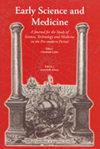Albrecht Dürer’s Drawing Devices: an Experimental Study
IF 0.5
2区 哲学
Q3 HISTORY & PHILOSOPHY OF SCIENCE
引用次数: 0
Abstract
In the two editions of hisAlbrecht drer的绘图装置:实验研究
在 1525 年和 1538 年出版的两版《Underweysung der Messung》中,阿尔布雷希特-丢勒发表了四种工具的设计图,以帮助艺术家进行绘画。本文作者重建了这四种工具并进行了实验,每次都绘制了一把琵琶。本文报告了遇到的问题和花费的时间。为了进行比较,作者用几何图形绘制了琵琶的透视图,并用手绘的方式绘制了其他图画。事实证明,两种更复杂的机器都不准确、耗时,几乎无法工作。网格框架更快、更准确。就速度和精度而言,最好的方法是在玻璃上进行描摹,在实验中,设置和绘制琵琶困难的曲线透视图所需的时间不到十分之一。论文沿袭了丢勒装置的历史传统。在文艺复兴时期的透视学文献中,这些复杂的机器被反复提及,但可以说在实践中却很少使用。相比之下,网格框架和在玻璃上描画则是许多教学课本中推荐的方法,直到二十世纪仍被艺术家广泛使用。
本文章由计算机程序翻译,如有差异,请以英文原文为准。
求助全文
约1分钟内获得全文
求助全文
来源期刊

Early Science and Medicine
HISTORY & PHILOSOPHY OF SCIENCE-
CiteScore
0.50
自引率
0.00%
发文量
22
审稿时长
>12 weeks
期刊介绍:
Early Science and Medicine (ESM) is a peer-reviewed international journal dedicated to the history of science, medicine and technology from the earliest times through to the end of the eighteenth century. The need to treat in a single journal all aspects of scientific activity and thought to the eighteenth century is due to two factors: to the continued importance of ancient sources throughout the Middle Ages and the early modern period, and to the comparably low degree of specialization and the high degree of disciplinary interdependence characterizing the period before the professionalization of science.
 求助内容:
求助内容: 应助结果提醒方式:
应助结果提醒方式:


